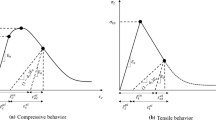Abstract
In order to explore the dynamic mechanical properties and damage evolution for concrete under the repeated impact loading, the large-diameter (74 mm) Split Hopkinson Pressure Bar (SHPB) was used to conduct the dynamic compression test. The damage was calculated by the Weibull statistical damage model, and the stress-strain curves of concrete were analyzed to study the repeated impact loading effects on the damage of concrete. Meanwhile, the fracture process of the concrete was simulated with the finite element software (LS-DYNA) and Johnson Holmquist Concrete (*MAT_JOHNSON_HOLMQUIST_CONCRETE) constitutive model. The results showed that the dynamic elastic modulus and the peak stress of the specimens decreased with the increased number of repeated impacts, while the peak strain increased. The damage of concrete increased with the increased strain, and the damage increased sharply after the “inflection point”. In addition, the results obtained by finite element simulation agree with the experimental results.
Similar content being viewed by others
References
Banthia, N., Mindess, S., Bentur, A., and Pigeon, M. (1989). “Impact testing of concrete using a drop-weight impact machine.” Experimental Mechanics, Vol. 29, No. 1, pp. 63–69 DOI: 10.1007/BF02327783.
Brara, A. and Klepaczko, J. R. (2004). “Dynamic tensile behavior of concrete: Experiment and numerical analysis.” ACI Materials Journal, Vol. 101, No. 2, pp. 162–167 DOI: 10.13140/RG.2.1.4270.2246.
Chen, X., Wu, S., and Zhou, J. (2013b). “Experimental and modeling study of dynamic mechanical properties of cement paste, mortar and concrete.” Construction and Building Materials, Vol. 47, pp. 419–430, DOI: 10.1016/j.conbuildmat.2013.05.063.
Chen, X., Wu, S., and Zhou, J. (2014). “Experimental study on dynamic tensile strength of cement mortar using split Hopkinson pressure bar technique.” Journal of Materials in Civil Engineering, Vol. 26, No. 6, 04014005, DOI: 10.1061/(ASCE)MT.1943-5533.0000926.
Chen, X., Wu, S., Zhou, J., Chen, Y., and Qin, A. (2013a). “Effect of testing method and strain rate on stress-strain behavior of concrete.” Journal of Materials in Civil Engineering, Vol. 25, No. 11, pp. 1752–1761 DOI: 10.1061/(ASCE)MT.1943-5533.0000732.
Deng, L. and Cai, C. S. (2010). “Development of dynamic impact factor for performance evaluation of existing multi-girder concrete bridges.” Engineering Structures, Vol. 32, No. 1, pp. 21–31 DOI: 10.1016/j.engstruct.2009.08.013.
Elfahal, M. M. and Krauthammer, T. (2005). “Dynamic size effect in normal-and high-strength concrete cylinders.” ACI Materials Journal, Vol. 102, No. 2, pp. 77–85.
Hao, Y. and Hao, H. (2013). “Dynamic compressive behaviour of spiral steel fibre reinforced concrete in split Hopkinson pressure bar tests.” Construction and Building Materials, Vol. 48, pp. 521–532 DOI: 10.1016/j.conbuildmat.2013.07.022.
Krajcinovic, D. and Silva, M. A. G. (1982). “Statistical aspects of the continuous damage theory.” International Journal of Solids and Structures, Vol. 18, No. 7, pp. 551–562 DOI: 10.1016/0020-7683(82)90039-7.
Lai, J. and Sun, W. (2010). “Dynamic damage and stress-strain relations of ultra-high performance cementitious composites subjected to repeated impact.” Science China-Technological Sciences, Vol. 53, No. 6, pp. 1520–1525 DOI: 10.1007/s11431-010-3133-2.
Lai, J., Sun, W., Xu, S., and Yang, C. (2013). “Dynamic properties of reactive powder concrete subjected to repeated impacts.” ACI Materials Journal, Vol. 110, No. 4, pp. 462–472. http://worldcat.org/oclc/13846872.
Malvar, L. J. and Ross, C. A. (1998). “Review of strain rate effects for concrete in tension.” ACI Materials Journal, Vol. 95, No. 6, pp. 735–739.
Manual, LS-DYNA Keyword User’s., and I. Volume. “Version 971.” Livermore Software Technology Corporation 7374, (2007).
Ong, K. C. G., Basheerkhan, M., and Paramasivam, P. (1999). “Resistance of fibre concrete slabs to low velocity projectile impact.” Cement and Concrete Composites, Vol. 21, No. 5, pp. 391–401 DOI: 10.1016/S0958-9465(99)00024-4.
Ross, C. A., Tedesco, J. W., and Kuennen, S. T. (1995). “Effects of strain rate on concrete strength.” ACI Materials Journal, Vol. 92, No. 1, pp. 37–47.
Thiagarajan, G. and Johnson, C. F. (2014). “Experimental behavior of reinforced concrete slabs subjected to shock loading.” ACI Structural Journal, Vol. 111, No. 6, pp. 1407–1418.
Tian, Z., Bu, J., Bian, C., and Peng, Z. (2016). “Effect of strain rate and saturation on uniaxial dynamic compressive behaviours of mortar.” International Journal of Pavement Engineering, Vol. 17, No. 9, pp. 789–798 DOI: 10.1080/10298436.2015.1019499.
Wang, Z. L., Zhu, H. H., and Wang, J. G. (2013). “Repeated-impact response of ultrashort steel fiber reinforced concrete.” Experimental Techniques, Vol. 37, No. 4, pp. 6–13 DOI: 10.1111/j.1747-1567.2011.00722.x.
Wang, Z., Tang, Y., and Wang, J. (2011). “Strength and toughness properties of steel fibre reinforced concrete under repetitive impact.” Magazine of Concrete Research, Vol. 63, No. 11, pp. 883–891 DOI: 10.1111/j.1747-1567.2011.00722.x.
Wu, M., Qin, C., and Zhang, C. (2013). “High strain rate splitting tensile tests of concrete and numerical simulation by mesoscale particle elements.” Journal of Materials in Civil Engineering, Vol. 26, No. 1, pp. 71–82 DOI: 10.1061/(ASCE)MT.1943-5533.0000776.
Wu, W., Zhang, W., and Ma, G. (2010). “Mechanical properties of copperslag reinforced concrete under dynamic compression.” Construction and Building Materials, Vol. 24, No. 6, pp. 910–917 DOI: 10.1016/j.conbuildmat.2009.12.001.
Xiao, J., Li, L., Shen, L., and Poon, C. S. (2015). “Compressive behaviour of recycled aggregate concrete under impact loading.” Cement and Concrete Research, Vol. 71, pp. 46–55 DOI: 10.1016/j.cemconres.2015.01.014.
Zhou, Y., Yang, W., Xia, Y., and Mallick, P. K. (2003). “An experimental study on the tensile behavior of a unidirectional carbon fiber reinforced aluminum composite at different strain rates.” Materials Science and Engineering: A, Vol. 362, No. 1, pp. 112–117 DOI: 10.1016/S0921-5093(03)00214-4.
Zhu, D., Mobasher, B., and Rajan, S. D. (2010). “Dynamic tensile testing of Kevlar 49 fabrics.” Journal of Materials in Civil Engineering, Vol. 23, No. 3, pp. 230–239 DOI: 10.1061/(ASCE)MT.1943-5533.0000156.
Author information
Authors and Affiliations
Corresponding author
Rights and permissions
About this article
Cite this article
Chen, X., Xu, L. & Zhu, Q. Mechanical behavior and damage evolution for concrete subjected to multiple impact loading. KSCE J Civ Eng 21, 2351–2359 (2017). https://doi.org/10.1007/s12205-016-1143-8
Received:
Accepted:
Published:
Issue Date:
DOI: https://doi.org/10.1007/s12205-016-1143-8




